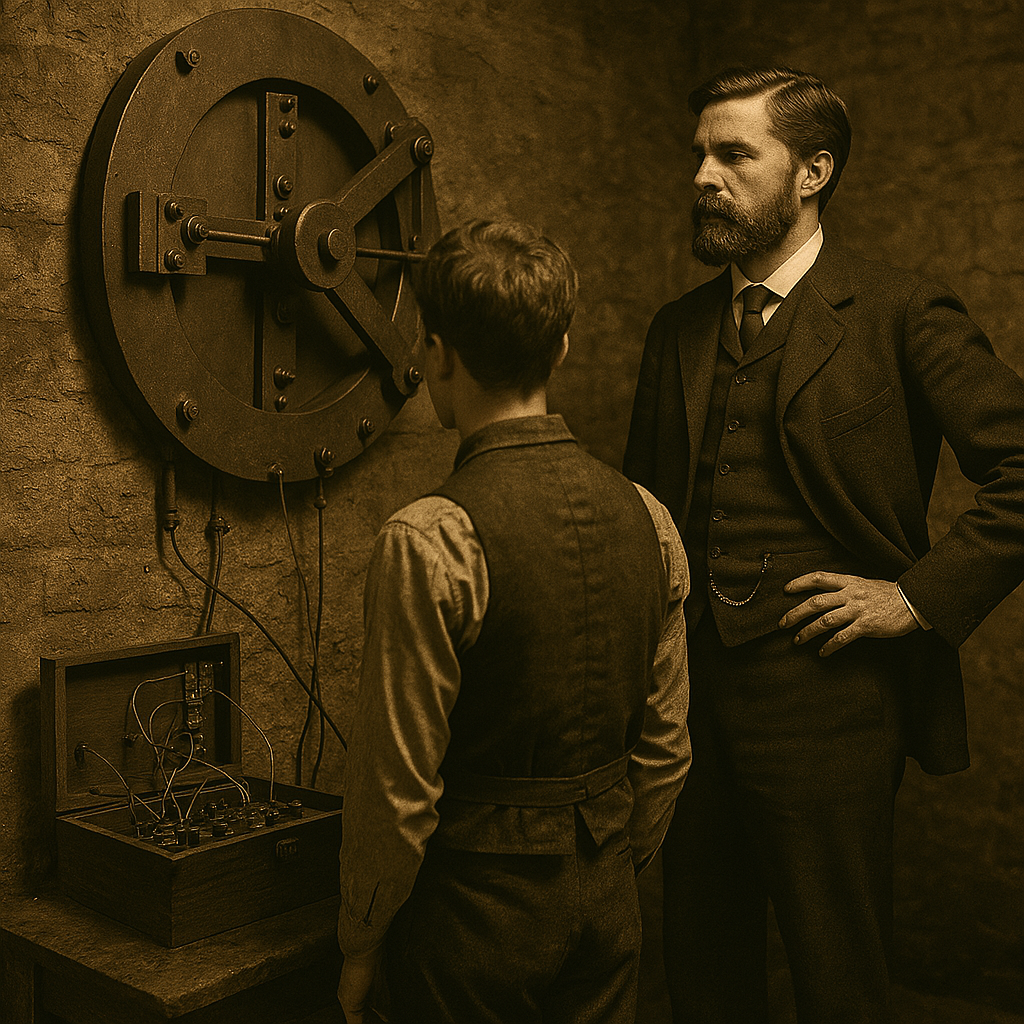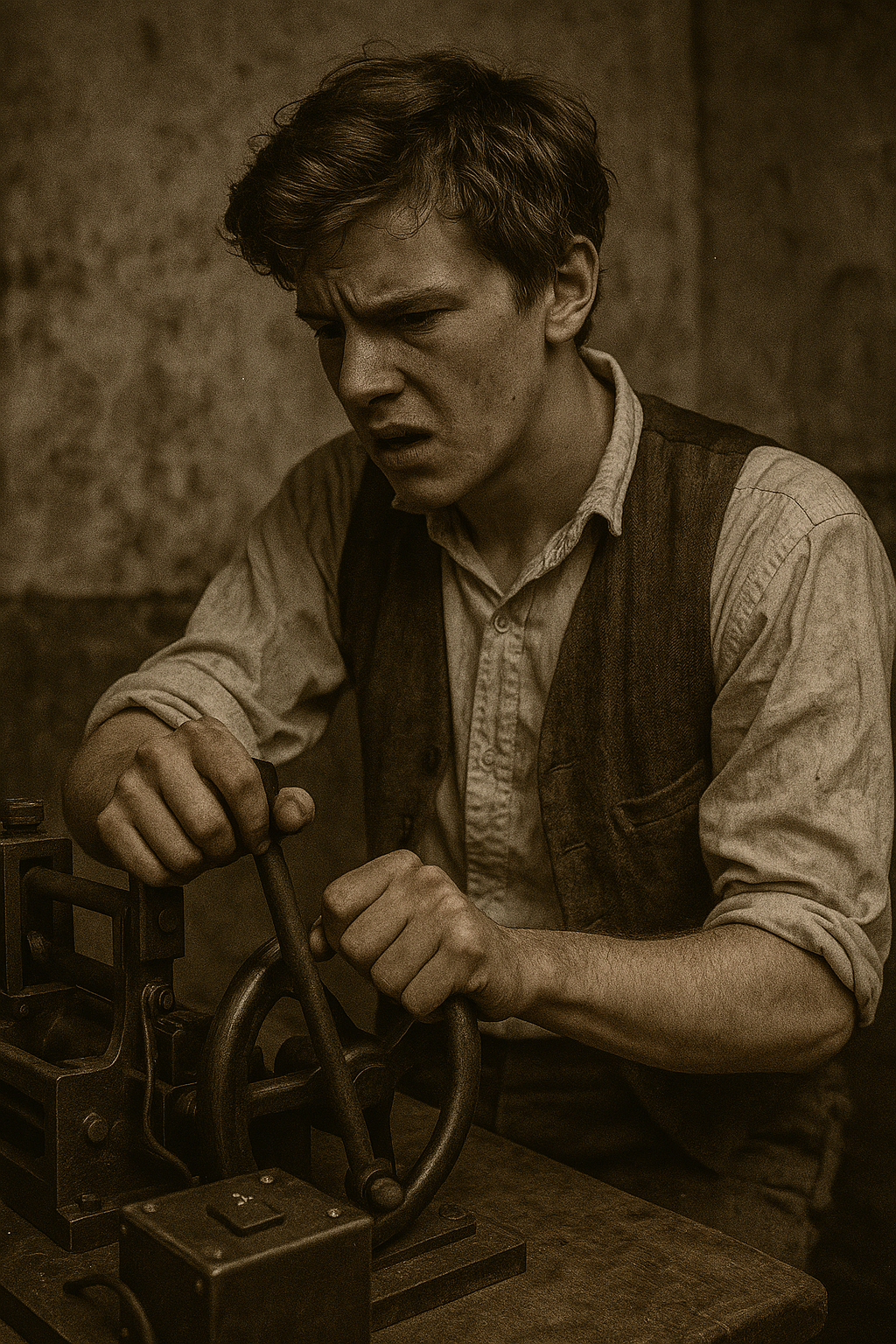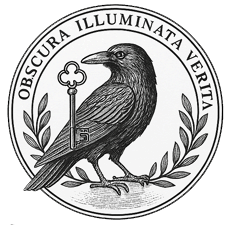Designation: T.H.M / Recurrence Vault Prototype
Constructed: 1876–1877
Inventor: Edwin Harcourt
Status: Dismantled (Reportedly)
Risk Level: Moderate–Unstable (Memory Echo Classification)

This sepia-toned photograph captures a rare glimpse inside the original Latch Chamber, a subterranean containment vault designed to test mechanical decision-making loops — or “conscious hinges,” as its inventor once described them. At the centre stands Edwin Harcourt, a precision mechanist and early StormCroft contractor, known for his obsession with devices that “only open when remembered.”
Beside him, partially obscured by steam and shadow, is Aide Thomas Elwell, then just 18, responsible for manually calibrating the chamber’s pressure valves and writing down “tones that never recurred.”
The chamber’s mechanisms were believed to respond to emotional states — refusing to unlock when approached with hesitation or anger. This photograph was found sealed inside a filing drawer labelled “DO NOT ARCHIVE – RECURSIVE MEMORY RISK.”
A locked sub-basement room with no confirmed inventor. The Latch Chamber reportedly amplifies intention—if one stands in the centre and speaks only inwardly, nearby radios broadcast fragments of thought. Sealed in 1933 after an incident where a worker “broadcast his grief” into an entire wing. Still sealed. Still faintly buzzing.
Overview
The Latch Chamber was an experimental StormCroft initiative designed to explore the possibility of mechanical memory entanglement — that is, the idea that a device might “remember” how and by whom it had previously been opened, and adjust its behaviour accordingly. In more practical terms, the chamber functioned as a locking mechanism that responded to emotional resonance rather than keys or codes.
Unlike conventional safes or containment units, the Latch Chamber was engineered to reject entry not based on unauthorised access, but on intent — the emotional and psychological state of the would-be entrant. It was said that if one approached the latch with doubt, guilt, or deceit, the chamber would remain shut. Approach with clarity, patience, or what Edwin Harcourt called “honest necessity,” and the latch might unseal — sometimes after a delay, sometimes before the handle was even touched.
Development and Structure
Built beneath the North Sub-Level of StormCroft’s Secondary Wing, the chamber was cylindrical and reinforced with iron alloy panels lined in what appeared to be folded copper mesh. Each panel was inscribed with tiny hand-scored marks — some believed them to be calibration notes, others emotional notation.
The chamber was fitted with:
-
Three pressure-triggered recognition wheels
-
A tuning dial to register harmonic echoes from the previous entry
-
A mechanism known as the Passive Core, which was never publicly explained, and which Edwin refused to document

A rare sepia-toned photograph showing 18-year-old Thomas Elwell mid-trial within the Latch Chamber’s testing corridor. The tension in his expression reflects the growing instability of the prototype mechanism, which by this stage had begun to anticipate contact and reject known personnel. Visible in the background is part of the original resonance coil — later removed during the chamber’s deactivation. This image was archived with a handwritten note: “He knew it before it moved.”
To test the chamber, Edwin required someone with absolute consistency of movement and temperament. That person was Thomas Elwell, then only eighteen — chosen for his steady pulse, measured tone, and his unusual sensitivity to shifts in ambient pressure. Edwin referred to Thomas as “the quiet centre of the coil.”
Incidents and Anomalies
The chamber’s first three trials were successful — it recognised Thomas’ approach and opened cleanly. However, on the fourth day, the chamber failed to open for Edwin, even after Thomas had calibrated it. When questioned, Thomas quietly confessed that he had dreamt of opening it without Edwin.
Thereafter, the Latch Chamber began to behave oddly:
-
It opened before being touched when Thomas entered the hallway
-
It remained shut for Edwin, even after direct contact
-
It triggered its own locking cycle after recognising laughter in an adjacent corridor
On the twelfth day, Edwin was recorded saying:
“The latch doesn’t need to know who. It needs to know why.”
Three days later, during a solo inspection, Edwin was reportedly locked inside the chamber for over six hours. When finally released, he was disoriented and claimed to have seen himself entering, again and again, “each time a little earlier.”
Closure and Aftermath
The chamber was sealed in late 1877 following a final trial in which the mechanism opened of its own accord in the middle of the night, with no one present. The entry log read: “Yes, now.” Edwin reportedly ordered the entire unit disassembled and its pieces scattered among unrelated storage wings. No single schematic survives.
As for the individuals:
-
Edwin Harcourt formally withdrew from StormCroft in 1878. He reportedly returned to Oxfordshire, where he took up the position of a night stationmaster. He died in 1889 of what was described as “prolonged internal confusion,” though the meaning remains unclear. His final written note read:
“It knows when you’re not looking.”
-
Thomas Elwell remained with StormCroft for another three years, eventually transferring to the Loop Archives. He vanished during the events surrounding Signal Cable Seven and was never seen again. His name continued to appear on access logs until 1893, five years after his disappearance.
Legacy and Theory
While The Latch Chamber was officially deemed a failed experiment, some believe its principles informed later StormCroft security systems — particularly those linked to intention-based routing and self-observing containment units. There are whispers that a second chamber was built, one that never required opening at all.
Rumours persist that the original core of the prototype — the “passive heart” — still ticks quietly inside Vault 3, and that it sometimes registers visitor presence seconds before they arrive.
The truth is unclear.
As Harcourt himself wrote, etched into the chamber’s inner wall:
“A lock does not keep you out. It asks if you’ve been here before.”
